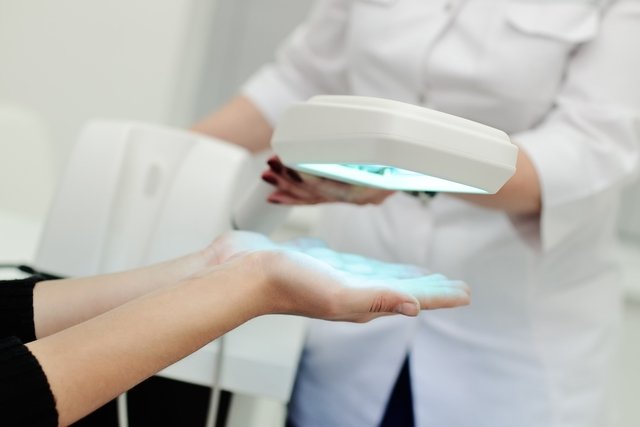Phototherapy is a treatment that uses artificial ultraviolet lights UVA or UVB that have anti-inflammatory and immunosuppressive action capable of stimulating or inhibiting cellular activity.
Phototherapy treatment is mainly used in newborns with jaundice, and can also be indicated in the treatment of psoriasis, chronic urticaria, atopic dermatitis, vitiligo or eczema, for example.
This type of treatment is simple and does not require preparation, it is only recommended that the person have their eyes covered throughout the session. Depending on the objective of the treatment, the doctor may also recommend the use of medicines to enhance the effects of phototherapy.

What is it for
Phototherapy is indicated for skin problems, such as:
- Psoriasis;
- Cutaneous T-cell lymphoma or mycosis fungoides;
- Pityriasis lichenoid planus or lichen planus;
- Atopic dermatitis or atopic eczema;
- Scleroderma;
- Vitiligo;
- Alopecia areata;
- Spontaneous chronic urticaria;
- Mastocytosis;
- Graft-versus-host disease.
Furthermore, phototherapy may be indicated in cases of neonatal jaundice or hyperbilirubinemia of the newborn, in which the baby has yellower skin due to the accumulation of the bilirubin pigment. Thus, when performing phototherapy, it is possible to favor the absorption of the light emitted by bilirubin, reducing its concentration in the baby’s blood. Learn more about hyperbilirubinemia in newborns.
The number of phototherapy sessions may vary according to the objective of the treatment and severity of the disease, and should always be indicated by the dermatologist.
Make an appointment with a dermatologist in the nearest region:
Taking care of your health has never been easier!
How it works
Phototherapy has anti-inflammatory and immunosuppressive effects, in addition to being useful for reducing the overproduction of cells in specific areas of the skin. Sometimes, to enhance the effects of phototherapy, the doctor may prescribe the use of medications such as retinoids, methotrexate or cyclosporine before exposure to light.
Carrying out phototherapy consists of applying light with an appropriate wave spectrum directly to the area to be treated, and it is important that the person has their eyes protected by an eye patch throughout the treatment.
How it is made
Phototherapy is carried out with different types of equipment, which emit ultraviolet light on the entire body or in specific regions of the skin, as instructed by the dermatologist, who must indicate the type of phototherapy to be used, as well as the wavelength and dose to be used. be applied.
To start phototherapy, some safety measures are necessary, such as wearing protective glasses, covering the genitals and using a face shield, which are provided by the doctor to carry out the procedure.
After undergoing phototherapy, it is recommended to use sunglasses with ultraviolet protection and sunscreen regularly, especially on areas of skin exposed to the sun.
Types of phototherapy
There are different types of phototherapy that can be done for skin problems, the main ones being:
- Narrowband UVB phototherapy: This type of phototherapy uses UVB radiation, with a more intense wavelength between 311 and 313nm, being more suitable and more effective for the treatment of psoriasis in adults. This phototherapy can only be done with the application of UVB light, and in this case it may be safe for pregnant women or children. Furthermore, this phototherapy can be done in association with topical retinoids, corticosteroids or vitamin D analogues, in which case it is contraindicated for pregnant women;
- Long band UVB phototherapy: This type of phototherapy is carried out by applying broad-spectrum UVB radiation lights, with wavelengths between 280-320nm. This type of phototherapy is currently the least used, due to its lower effectiveness and greater risk of side effects;
- UVA phototherapy with psoralen (PUVA): is a type of combined treatment that consists of first taking orally or applying a substance called psoralen to the skin, recommended by the doctor, which makes the skin more sensitive to the treatment, and 2 hours later, exposing the area of skin that will be treated with UVA radiation, indicated especially in cases of vitiligo, psoriasis, eczema, lichen planus or urticaria pigmentosa, for example.
The type of phototherapy must be indicated by the dermatologist, according to the condition to be treated, previous treatments, stage of the disease and severity of symptoms.
Neonatal phototherapy
Neonatal phototherapy is indicated in cases of jaundice or hyperbilirubinemia, which cause yellowish skin and eyes in the baby, due to the deposition of bilirubin in the skin, which is a pigment produced when red blood cells decompose. Thus, phototherapy allows excess bilirubin to be eliminated through urine, preventing neurological complications in the baby.
To ensure the effectiveness of this treatment, it is important that the light emitted has a wavelength capable of being absorbed by bilirubin and that attention is paid to the initial concentration of bilirubin, as this way it is possible to indicate the number of sessions needed.
The newborn is generally placed under a white or blue light, which can be placed 30 or 50 cm away from their skin, with their eyes properly covered with a specific blindfold, for the time determined by the pediatrician.
Possible side effects
Side effects that may arise due to exposure to ultraviolet radiation from phototherapy are:
- Aging of treated skin;
- Skin redness, which peaks 12 to 24 hours after treatment;
- Burning sensation on treated skin;
- Pain, swelling or blistering in the treated area;
- Reactivation of the cold sore virus;
- Formation of blisters in psoriasis plaques;
- Dry or wrinkled skin;
- Changes in the color of the treated skin;
- Loss of elasticity or greater fragility of the skin.
Furthermore, in the case of PUVA phototherapy, intense pain in the skin, malaise, fever, damage to the nail bed, hemorrhage or bleeding under the nails, nausea, lentigines or keratoses, for example, may also occur. Another side effect of PUVA is the increased risk of developing cataracts, which is why protection with special glasses is recommended during treatment.
Can phototherapy cause cancer?
Phototherapy, especially PUVA phototherapy, may increase the risk of developing skin cancer, such as squamous cell carcinoma or melanoma, when used for long periods and at an inappropriate wavelength, in susceptible people, such as those with cases of skin cancer in the family.
Phototherapy treatment should only be carried out with a dermatologist’s recommendation, following their recommendations regarding the number of sessions and duration of each session so that this is a safe method of treatment.
When it is not recommended
Phototherapy should not be performed in the following situations:
- Systemic lupus erythematosus;
- Dermatomyositis or xeroderma pigmentoso?
- Albinism, pemphigus or porphyria;
- History of melanoma and/or non-melanoma skin cancer;
- History of exposure to arsenic or ionizing radiation;
- Treatment with immunosuppressants;
- Severe liver failure;
- Photosensitivity.
Furthermore, phototherapy should not be used in cases where the newborn has hyperbilirubinemia due to kidney or liver problems.
PUVA phototherapy is also contraindicated for children, pregnant or breastfeeding women, or people who have cataracts or use medications such as warfarin or phenytoin.

Sign up for our newsletter and stay up to date with exclusive news
that can transform your routine!
Warning: Undefined array key "title" in /home/storelat/public_html/wp-content/plugins/link-whisper-premium/templates/frontend/related-posts.php on line 12
Warning: Undefined array key "title_tag" in /home/storelat/public_html/wp-content/plugins/link-whisper-premium/templates/frontend/related-posts.php on line 13



